Scandinavian Three-storey Exterior Design Ideas
Refine by:
Budget
Sort by:Popular Today
61 - 80 of 270 photos
Item 1 of 3
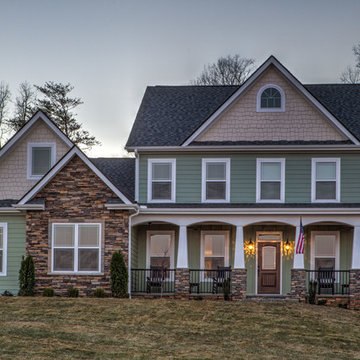
Front
Photo of a large scandinavian three-storey brick brown exterior in Other with a gable roof.
Photo of a large scandinavian three-storey brick brown exterior in Other with a gable roof.
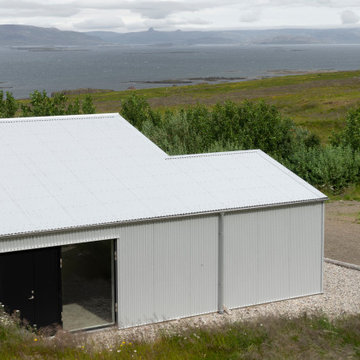
The Guesthouse Nýp at Skarðsströnd is situated on a former sheep farm overlooking the Breiðafjörður Nature Reserve in western Iceland. Originally constructed as a farmhouse in 1936, the building was deserted in the 1970s, slowly falling into disrepair before the new owners eventually began rebuilding in 2001. Since 2006, it has come to be known as a cultural hub of sorts, playing host to various exhibitions, lectures, courses and workshops.
The brief was to conceive a design that would make better use of the existing facilities, allowing for more multifunctional spaces for various cultural activities. This not only involved renovating the main house, but also rebuilding and enlarging the adjoining sheep-shed. Nýp’s first guests arrived in 2013 and where accommodated in two of the four bedrooms in the remodelled farmhouse. The reimagined sheep shed added a further three ensuite guestrooms with a separate entrance. This offers the owners greater flexibility, with the possibility of hosting larger events in the main house without disturbing guests. The new entrance hall and connection to the farmhouse has been given generous dimensions allowing it to double as an exhibition space.
The main house is divided vertically in two volumes with the original living quarters to the south and a barn for hay storage to the North. Bua inserted an additional floor into the barn to create a raised event space with a series of new openings capturing views to the mountains and the fjord. Driftwood, salvaged from a neighbouring beach, has been used as columns to support the new floor. Steel handrails, timber doors and beams have been salvaged from building sites in Reykjavik old town.
The ruins of concrete foundations have been repurposed to form a structured kitchen garden. A steel and polycarbonate structure has been bolted to the top of one concrete bay to create a tall greenhouse, also used by the client as an extra sitting room in the warmer months.
Staying true to Nýp’s ethos of sustainability and slow tourism, Studio Bua took a vernacular approach with a form based on local turf homes and a gradual renovation that focused on restoring and reinterpreting historical features while making full use of local labour, techniques and materials such as stone-turf retaining walls and tiles handmade from local clay.
Since the end of the 19th century, the combination of timber frame and corrugated metal cladding has been widespread throughout Iceland, replacing the traditional turf house. The prevailing wind comes down the valley from the north and east, and so it was decided to overclad the rear of the building and the new extension in corrugated aluzinc - one of the few materials proven to withstand the extreme weather.
In the 1930's concrete was the wonder material, even used as window frames in the case of Nýp farmhouse! The aggregate for the house is rather course with pebbles sourced from the beach below, giving it a special character. Where possible the original concrete walls have been retained and exposed, both internally and externally. The 'front' facades towards the access road and fjord have been repaired and given a thin silicate render (in the original colours) which allows the texture of the concrete to show through.
The project was developed and built in phases and on a modest budget. The site team was made up of local builders and craftsmen including the neighbouring farmer – who happened to own a cement truck. A specialist local mason restored the fragile concrete walls, none of which were reinforced.
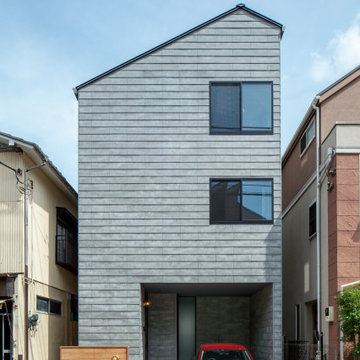
Mid-sized scandinavian three-storey grey house exterior in Yokohama with concrete fiberboard siding, a gable roof, a metal roof, a grey roof and clapboard siding.
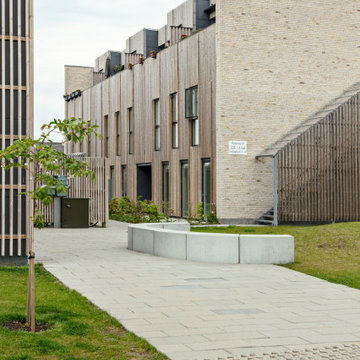
Kirsebærhaven en etagebebyggelse, hvor det arkitektoniske greb er med til at understøtte en bebyggelse, hvor fællesskab og privatliv går hånd i hånd.
Der er lagt vægt på at skabe ydre og indre rum, hvor gode lysforhold og gedigne, naturlige materialer skaber velvære og trivsel.
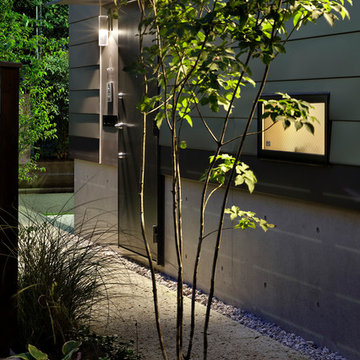
Photo Copyright Satoshi Shigeta
Photo of a small scandinavian three-storey multi-coloured house exterior in Tokyo with metal siding, a gable roof and a metal roof.
Photo of a small scandinavian three-storey multi-coloured house exterior in Tokyo with metal siding, a gable roof and a metal roof.
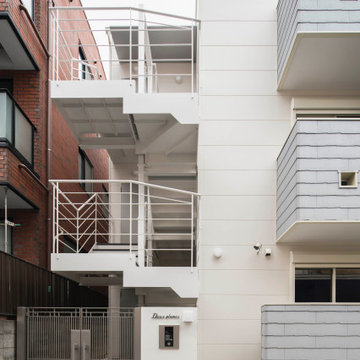
不動前の家
グレーと白の淡いグラディエーションの外観です。
猫と住む、多頭飼いのお住まいです。
株式会社小木野貴光アトリエ一級建築士建築士事務所
https://www.ogino-a.com/
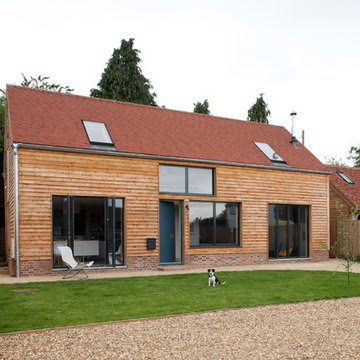
Kristen McCluskie, Simon Maxwell
This is an example of a mid-sized scandinavian three-storey beige house exterior in Buckinghamshire with wood siding and a gable roof.
This is an example of a mid-sized scandinavian three-storey beige house exterior in Buckinghamshire with wood siding and a gable roof.
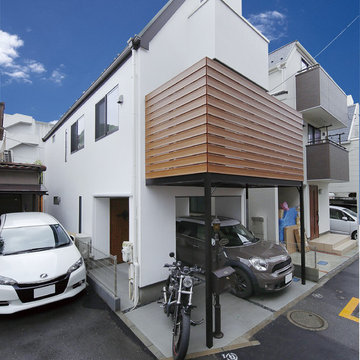
しっくい を外壁に使ったきれいでやさしい印象のY様邸。北側斜線をかわしながら内部空間を楽しく生かしています。
Design ideas for a scandinavian three-storey stucco white house exterior in Tokyo with a shed roof.
Design ideas for a scandinavian three-storey stucco white house exterior in Tokyo with a shed roof.
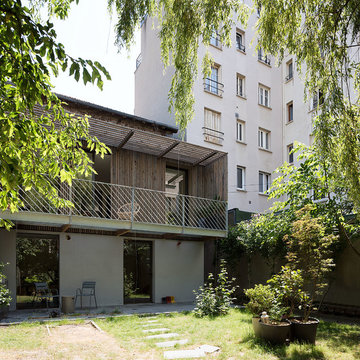
vue depuis l'arrière du jardin de l'extension
Mid-sized scandinavian three-storey beige townhouse exterior in Paris with wood siding, a flat roof, a green roof and clapboard siding.
Mid-sized scandinavian three-storey beige townhouse exterior in Paris with wood siding, a flat roof, a green roof and clapboard siding.
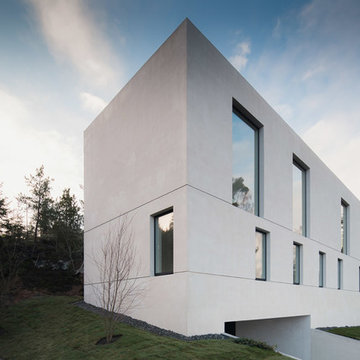
Design ideas for a large scandinavian three-storey white exterior in Stockholm with stone veneer and a flat roof.
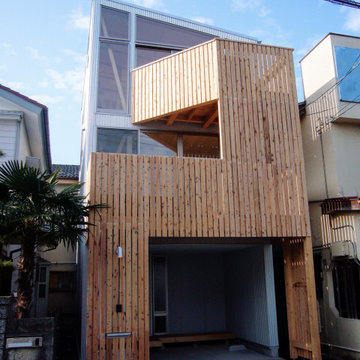
道に面して木製ルーバーで構成したバルコニーを設けた。このバルコニーが外と室内とをゆるやかにつなぐ。
バルコーニーは二階と三階に設置。二階室内への東南からの採光を妨げないように、三階のバルコニーを斜めに切り取った。これがバルコニーの形に豊かな表情とユーモラスな印象を与える。
Inspiration for a small scandinavian three-storey grey house exterior in Other with metal siding, a shed roof and a metal roof.
Inspiration for a small scandinavian three-storey grey house exterior in Other with metal siding, a shed roof and a metal roof.
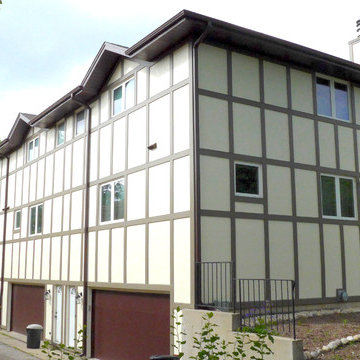
Siding & Windows Group completed this Glencoe, IL Tudor Style Townhouses in HardiePanel Vertical Siding in ColorPlus Technology Color Cobble Stone with Dark Brown Custom ColorPlus Technology Color HardieTrim.
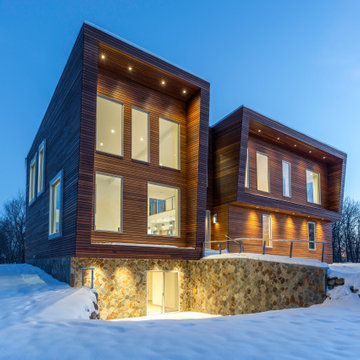
WARM MODERN DESIGN FOR A COLD LOCATOIN
Large scandinavian three-storey brown house exterior in Detroit with wood siding, a shed roof and a mixed roof.
Large scandinavian three-storey brown house exterior in Detroit with wood siding, a shed roof and a mixed roof.
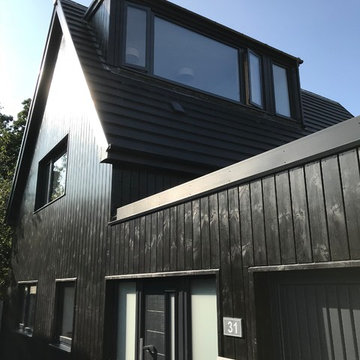
Design ideas for a mid-sized scandinavian three-storey black house exterior in Other with wood siding, a gable roof and a tile roof.
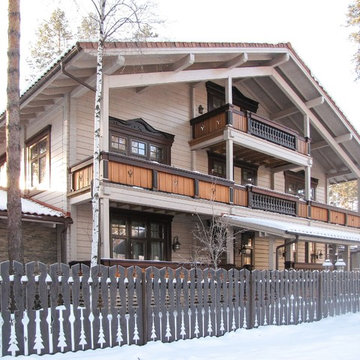
Scandinavian three-storey beige house exterior in Yekaterinburg with wood siding and a gable roof.
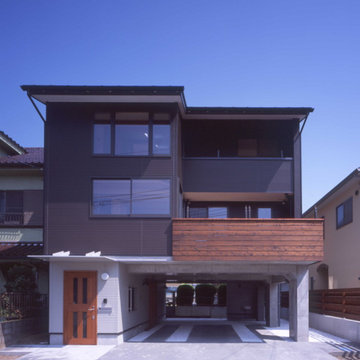
RC+木造の3階建ての住宅。
ピロティには2台分の駐車場があり、ここから物置にもアプローチできる。
This is an example of a mid-sized scandinavian three-storey brown house exterior in Other with mixed siding, a shed roof, a metal roof and a black roof.
This is an example of a mid-sized scandinavian three-storey brown house exterior in Other with mixed siding, a shed roof, a metal roof and a black roof.
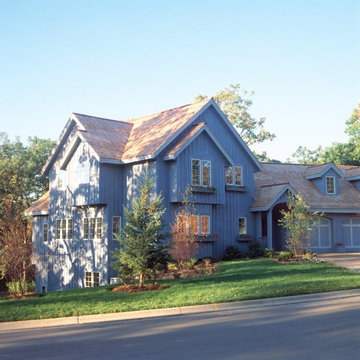
Photography by Susan Gilmore. Used with permission from
Midwest Living
magazine. © 1990 Meredith Corporation.
All rights reserved.
Photo of a large scandinavian three-storey blue exterior in Minneapolis with wood siding and a gable roof.
Photo of a large scandinavian three-storey blue exterior in Minneapolis with wood siding and a gable roof.
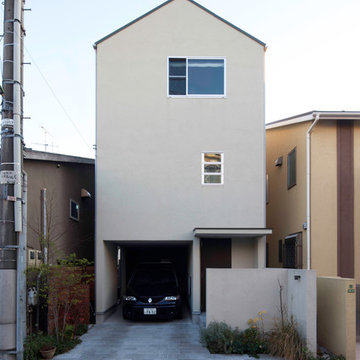
Photo of a mid-sized scandinavian three-storey stucco beige house exterior in Tokyo with a gable roof and a metal roof.
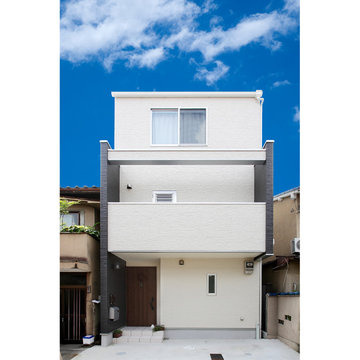
京都市内、路地が入り込む敷地に建つM氏邸。前面道路は3.6m、間口は4.6mの厳しい条件であったが、スタイリッシュなキュービック型の外観デザインを実現
Small scandinavian three-storey white house exterior in Kyoto.
Small scandinavian three-storey white house exterior in Kyoto.
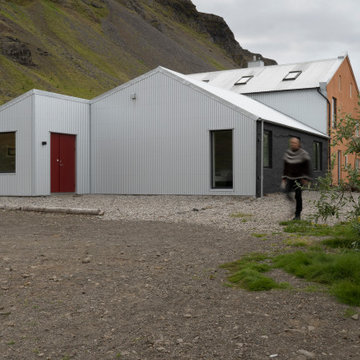
The Guesthouse Nýp at Skarðsströnd is situated on a former sheep farm overlooking the Breiðafjörður Nature Reserve in western Iceland. Originally constructed as a farmhouse in 1936, the building was deserted in the 1970s, slowly falling into disrepair before the new owners eventually began rebuilding in 2001. Since 2006, it has come to be known as a cultural hub of sorts, playing host to various exhibitions, lectures, courses and workshops.
The brief was to conceive a design that would make better use of the existing facilities, allowing for more multifunctional spaces for various cultural activities. This not only involved renovating the main house, but also rebuilding and enlarging the adjoining sheep-shed. Nýp’s first guests arrived in 2013 and where accommodated in two of the four bedrooms in the remodelled farmhouse. The reimagined sheep shed added a further three ensuite guestrooms with a separate entrance. This offers the owners greater flexibility, with the possibility of hosting larger events in the main house without disturbing guests. The new entrance hall and connection to the farmhouse has been given generous dimensions allowing it to double as an exhibition space.
The main house is divided vertically in two volumes with the original living quarters to the south and a barn for hay storage to the North. Bua inserted an additional floor into the barn to create a raised event space with a series of new openings capturing views to the mountains and the fjord. Driftwood, salvaged from a neighbouring beach, has been used as columns to support the new floor. Steel handrails, timber doors and beams have been salvaged from building sites in Reykjavik old town.
The ruins of concrete foundations have been repurposed to form a structured kitchen garden. A steel and polycarbonate structure has been bolted to the top of one concrete bay to create a tall greenhouse, also used by the client as an extra sitting room in the warmer months.
Staying true to Nýp’s ethos of sustainability and slow tourism, Studio Bua took a vernacular approach with a form based on local turf homes and a gradual renovation that focused on restoring and reinterpreting historical features while making full use of local labour, techniques and materials such as stone-turf retaining walls and tiles handmade from local clay.
Since the end of the 19th century, the combination of timber frame and corrugated metal cladding has been widespread throughout Iceland, replacing the traditional turf house. The prevailing wind comes down the valley from the north and east, and so it was decided to overclad the rear of the building and the new extension in corrugated aluzinc - one of the few materials proven to withstand the extreme weather.
In the 1930's concrete was the wonder material, even used as window frames in the case of Nýp farmhouse! The aggregate for the house is rather course with pebbles sourced from the beach below, giving it a special character. Where possible the original concrete walls have been retained and exposed, both internally and externally. The 'front' facades towards the access road and fjord have been repaired and given a thin silicate render (in the original colours) which allows the texture of the concrete to show through.
The project was developed and built in phases and on a modest budget. The site team was made up of local builders and craftsmen including the neighbouring farmer – who happened to own a cement truck. A specialist local mason restored the fragile concrete walls, none of which were reinforced.
Scandinavian Three-storey Exterior Design Ideas
4